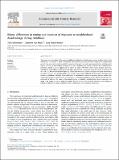Files in this item
Ethnic differences in timing and duration of exposure to neighborhood disadvantage during childhood
Item metadata
| dc.contributor.author | Kleinepier, Tom | |
| dc.contributor.author | Nieuwenhuis, Jaap | |
| dc.contributor.author | van Ham, Maarten | |
| dc.date.accessioned | 2018-04-25T08:30:06Z | |
| dc.date.available | 2018-04-25T08:30:06Z | |
| dc.date.issued | 2018-06 | |
| dc.identifier | 252838587 | |
| dc.identifier | f78835bd-2fe1-446a-b013-b6cbb58c2da0 | |
| dc.identifier | 85049936633 | |
| dc.identifier | 000433646400009 | |
| dc.identifier.citation | Kleinepier , T , Nieuwenhuis , J & van Ham , M 2018 , ' Ethnic differences in timing and duration of exposure to neighborhood disadvantage during childhood ' , Advances in Life Course Research , vol. 36 , pp. 92-104 . https://doi.org/10.1016/j.alcr.2018.04.003 | en |
| dc.identifier.issn | 1040-2608 | |
| dc.identifier.other | RIS: urn:73A764788E6B51DBD76C76F665142730 | |
| dc.identifier.other | ORCID: /0000-0002-2106-0702/work/64697586 | |
| dc.identifier.uri | https://hdl.handle.net/10023/13198 | |
| dc.description | The research leading to these results has received funding from the European Research Council under the European Union's Seventh Framework Programme (FP/2007-2013) / ERC Grant Agreement n. 615159 (ERC Consolidator Grant DEPRIVEDHOODS, Socio-spatial inequality, deprived neighbourhoods, and neighbourhood effects). | en |
| dc.description.abstract | This paper examines ethnic differences in childhood neighborhood disadvantage among children living in the Netherlands. In contrast to more conventional approaches for assessing children’s exposure to neighborhood poverty (e.g., point-in-time and cumulative measures of exposure), we apply sequence analysis to simultaneously capture the timing and duration of exposure to poor neighborhoods during childhood. Rich administrative microdata offered a unique opportunity to follow the entire 1999 birth cohort of the Turkish, Moroccan, Surinamese, and Antillean second generation and a native Dutch comparison group from birth up until age 15 (N = 24,212). Results indicate that especially Turkish and Moroccan children had higher odds than native Dutch children to live in a poor neighborhood at any specific stage during childhood, but particularly throughout the entirety of childhood. Although ethnic differences in neighborhood income trajectories became smaller after adjusting for parental and household characteristics, a substantial proportion of the differences remained unexplained. In addition, the impact of household income on children’s neighborhood income trajectories was found to be weaker for ethnic minority children than for native Dutch children. We discuss our findings in relation to theories on spatial assimilation, place stratification, and residential preferences. | |
| dc.format.extent | 13 | |
| dc.format.extent | 1258564 | |
| dc.language.iso | eng | |
| dc.relation.ispartof | Advances in Life Course Research | en |
| dc.subject | Childhood | en |
| dc.subject | Ethnicity | en |
| dc.subject | Life course | en |
| dc.subject | Neighborhood | en |
| dc.subject | Sequence analysis | en |
| dc.subject | H Social Sciences (General) | en |
| dc.subject | HQ The family. Marriage. Woman | en |
| dc.subject | HT Communities. Classes. Races | en |
| dc.subject | 3rd-NDAS | en |
| dc.subject.lcc | H1 | en |
| dc.subject.lcc | HQ | en |
| dc.subject.lcc | HT | en |
| dc.title | Ethnic differences in timing and duration of exposure to neighborhood disadvantage during childhood | en |
| dc.type | Journal article | en |
| dc.contributor.sponsor | European Research Council | en |
| dc.contributor.institution | University of St Andrews. School of Geography & Sustainable Development | en |
| dc.identifier.doi | https://doi.org/10.1016/j.alcr.2018.04.003 | |
| dc.description.status | Peer reviewed | en |
| dc.identifier.grantnumber | ERC-2013-CoG | en |
This item appears in the following Collection(s)
Items in the St Andrews Research Repository are protected by copyright, with all rights reserved, unless otherwise indicated.

